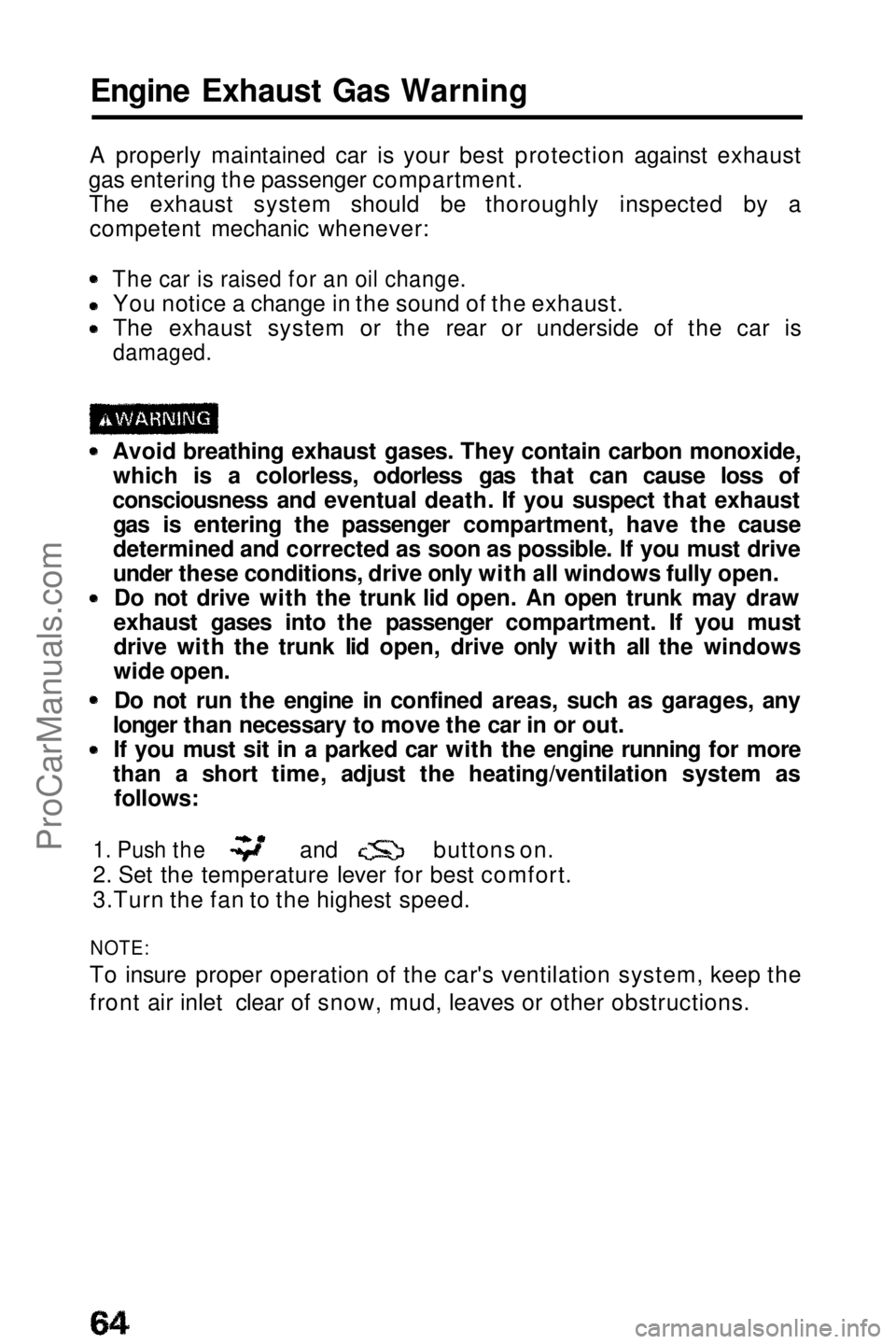1990 HONDA PRELUDE window
[x] Cancel search: windowPage 57 of 143

Open
Close
Fuel vapor is extremely hazardous under certain conditions.
Always stop the engine before refueling, and never refuel near
sparks or open flames.
CAUTION:
When reinstalling the fuel cap, be sure both tabs on the cap are engaged in the slots of the filler neck and turn the cap until it stops.
If you replace the cap, use only a genuine Honda replacement part
or Its equivalent. Failure to use the proper part could cause serious
fuel system problems.
How to Improve Your Gas Mileage:
Drive at a smooth, steady pace to avoid unnecessary
decelerations and stops — accelerating back to speed uses more
fuel.
Plan trips to avoid rush hour traffic if possible.Make sure the parking brake is completely released.
Consolidate trips whenever possible.
Keep vehicle weight to a minimum by removing unnecessary
items from the luggage area.
Whenever possible, use fresh air from the dash vents to keep
cool when driving; open windows, or use of the air conditioningboth affect fuel economy.
Keep the tires adjusted to the recommended pressure.
Tire Pressure (measured cold)
Front: 195 kPa (28 psi)
Rear: 180 kPa (26 psi)
195 kPa (28 psi) : (Si with 4WS)
Condition of Your Car
You can only get maximum fuel economy if your car is in top running condition. Have all required maintenance done at theproper intervals. Check tire pressures and tire wear frequently. If
tire wear is uneven, have the alignment checked by your Honda dealer. Proper alignment saves gasoline and prolongs tire life.
RELEASE LEVER
Pull upProCarManuals.comMain Menu t s
Page 63 of 143

Safety Items
Before driving away, check that: The doors are closed properly. The mirrors are properly adjusted, and the windows clean.
The driver and passengers are wearing properly adjusted seat
belts.
The head restraints are properly adjusted.
The warning and indicator lights are operating properly.
The brake pedal feels normal.
All luggage and cargo is secured.
Nothing is interfering with the driver's feet or blocking vision to
the rear.
While driving remember to: Always drive defensively; expect the unexpected. Reduce your speed during night hours and bad weather.
Follow at a safe distance; don't tailgate.
Get off the highway when you are tired; stop and take a rest.
When stopping for repairs: Park the car well off the road.
Turn on the hazard warning flasher. Use flares or other warning devices to warn other motorists.
After parking your car: Apply the parking brake and shift to first gear if equipped withmanual transmission, or PARK on automatic transmission
equipped cars.
Make sure the windows are closed and all doors are locked.
If parked on a hill:
Turn the front wheels away from the curb if facing uphill.
Turn the front wheels toward the curb if facing downhill. Never leave children unattended in a parked car.
Take your
keys.ProCarManuals.comMain Menu t s
Page 64 of 143

Engine Exhaust Gas Warning
A properly maintained car is your best protection against exhaust
gas entering the passenger compartment. The exhaust system should be thoroughly inspected by acompetent mechanic whenever:
The car is raised for an oil change.
You notice a change in the sound of the exhaust.
The exhaust system or the rear or underside of the car is
damaged.
Avoid breathing exhaust gases. They contain carbon monoxide, which is a colorless, odorless gas that can cause loss of
consciousness and eventual death. If you suspect that exhaust gas is entering the passenger compartment, have the cause
determined and corrected as soon as possible. If you must drive
under these conditions, drive only with all windows fully open. Do not drive with the trunk lid open. An open trunk may draw
exhaust gases into the passenger compartment. If you must
drive with the trunk lid open, drive only with all the windows
wide open.
Do not run the engine in confined areas, such as garages, any
longer than necessary to move the car in or out. If you must sit in a parked car with the engine running for more
than a short time, adjust the heating/ventilation system as
follows:
1. Push the
and buttons on.
2. Set the temperature lever for best comfort.
3.Turn the fan to the highest speed.
NOTE:
To insure proper operation of the car's ventilation system, keep the
front air inlet clear of snow, mud, leaves or other obstructions.ProCarManuals.comMain Menu t s
Page 110 of 143

Appearance Care
Interior Trim
Remove dust and loose dirt with a vacuum cleaner.
Wipe the vinyl with a clean, damp cloth or sponge. Stains can be removed with a commercially available vinyl cleaner.
CAUTION:
Do not use thinner, gasoline, kerosene, naphtha or other solvents
on the interior. They are toxic, flammable and hazardous and could damage the material you're cleaning.
Windows A 10 to 1 mix of water and white vinegar, or a commercially
available glass cleaner may be used to clean windows and to remove
the dust film sometimes caused by the ingredients used in interior vinyls and plastics.
NOTE:
Do not put this solution in the windshield washer reservoir, it will
damage the windshield washer pump.
Be careful not to scratch or damage the defogger wires when
cleaning the inside of the rear window; wipe the window horizontally along the wires, not up and down. Dry the windows
with a lint-free cloth or paper towel. Keep all the windows clean formaximum visibility.
Exterior Care
Waxing Wax the car when water will no longer "bead" on the paint. Always wash and dry the car before you wax it.
Use a good quality liquid or paste wax, and follow the manufacturer's
instructions. Wax all the metal trim to keep its luster.
NOTE:
Removing oil, tar, etc., with a spot remover will usually strip the
wax from the surrounding finish. Be sure to re-wax these areas even if the rest of the car does not yet need waxing.ProCarManuals.comMain Menu t s
Page 139 of 143

Keys
Door Locks ..................................3
Glove box ..................................39
Trunk Lid Lock ............................4
Ignition ........................................58
Key Reminder Beeper...............58Keys.............................................3
Lap/Shoulder Belts
................................Se
e "Seat Belts"
Light
Bulb Replacement...................103
Fuse Replacement ..................101
Light Reminder
Chime ..............30
Operation.................................30
Warning and Indicator Light
......................................................21
Locks
Fuel Filler Door ..........................56
Doors..........................................3
Glove Bo
x ..................................39
Trunk Lid......................................4
Anti-theft Steering
Column
Lock.......................................58
Lumbar Support,Driver's .................7
Maintenace Schedule
and
Records......................................76
Manual Transmission Maximum Allowable Speeds
....................................................66
Oil........................................86
Recommended Shift
Speeds
....................................................66
Shifting.....................................65
Meters Gauges.......See
"Gauges"
Mirrors Power Mirrors ...........................29
Rear View Mirrors ....................29 Numbers, Identification................ 127
Octane Rating,
Gasoline
.......................................... See "Fuel"
Odometer ........................................20Oil
Engine Oil ...................................83
Fluid Locations ..........................82Transmission Oil/Fluid ..............86Oil Pressure Warning Light.......22
Power Steering Fluid ................97
Operation In
Foreign Countries
..........................................................56
Panel Brightness Control ...............33
Parking Brake.................................
39
Power
Mirrors .......................................29
Steering .....................................
97
Windows................................40
PGM-FI System............................131
Pressures, Tire Inflation...............105
Preventive Service.......................
112
(cont'd)
Radiator Coolant .............................88
Radio ................................................47
Rear View Mirrors ..........................29
Rear Window Defogger ..................28
Reminder Lights
..........................See "Warning lights"ProCarManuals.comMain Menu t s
Page 141 of 143

Tread Wear................................... 128
Trip Meter........................................20
Trunk.................................................4
Trunk Access From
Rear Seat ................................9
Trunk Lid......................................4
Trunk Light ................................34
Trunk-Open
Indicator Light .......................25
Turn Signals.....................................30
Vehicle Identification Number
....................................................127
Ventilation .......................................41
Warning Lights ................................21
Warranty Service .........................135
Washer
Reservoir Capacity ...................
27
Windshield Washer ...................27
Washing.........................................110
Waxing ..........................................111
Wheels...........................................111
Windows
Appearance Care....................
110
Power Windows .......................40
Windshield Defogger .......................28
Windshield Washer.........................27
Windshield Wipers ..........................27
Wiper Blades
...................................94
Wipers
Windshield Wipers ....................27
ProCarManuals.comMain Menu t s